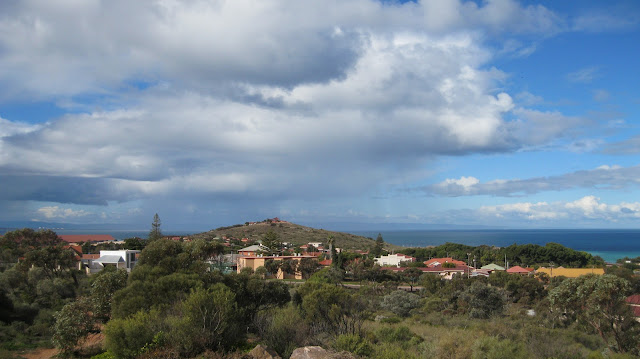Thursday
26th July
We
realized today that we have been on the Eyre Peninsula for two weeks, and while
we have certainly seen quite a bit, there is a significant area in the middle
which remains unexplored by us. Another
time!!
We
were on the road by 9 am from Cowell on route to Whyalla. While our knowledge of Whyalla is basic and
only elicits iron ore when prompted, we thought we should be more open minded
and visit the information office to see what is on offer for us. As soon as we entered the lovely warm office
the lady asked if we were there for the 11 o’clock tour. We were not aware of any tours having just
driven in, so she explained it was a tour of the ship “Whyalla” sitting right
next to the information centre. There was no good reason not to go onboard, so
a guide took us all over this ship, which was built as a ‘mine-sweeper’ and was
the first ship built in Whyalla in 1941.
Following
the outbreak of World War II, the Government asked BHP if they could develop a
shipyard for the war effort. In 1940 BHP
Newcastle recruited seven shipbuilding personnel from the United Kingdom to
establish a shipyard at Whyalla, South Australia. One was soon dismissed after expressing his
dismay with the flies and heat of Whyalla, the others set to and developed a
yard that built 634 ships, an oil rig and two barges over the next 38 years.
In
1947 the Victorian Ports and Harbours Department bought the Whyalla and renamed
her the RIP. Her role was to perform
dredging work in Port Phillip Bay in a narrow and treacherously turbulent
entrance in area known as “The Rip”.
In
1987 money was raised to bring her back to South Australia, where she was
restored as the Whyalla just as when first built and brought ashore to be
mounted as the central exhibit for the Whyalla Maritime Museum. Although she was purchased back from Victoria
for only $5000, it took another $560,000 to remove her from the sea and haul
her the 2 kilometres on shore to set her up as she is today.
As I
had left my camera in the car for the duration of this tour, I am using a photo
I found on the net to display some of what we saw.
There
is a lookout which gives views of the Spencer Gulf and has statues of Matthew
Flinders and Louis-Claude de Freycinet, both of whom had navigated and charted
this coast of South Australia. A good place to enjoy our lunch while looking at
the Gulf.
A hill nearby, which is seen in this picture named Hummock Hill was our next stop.
This was quite a steep climb
and I can see why part of this hill was used as a fortification during the Second
World War as it has 360 degree views of Whyalla the OneSteel operations, the
foreshore and marina, and as far as the Point Lowly lighthouse.
In
fact tonight we are camping at Point Lowly and I have just returned from a very
enjoyable walk around the lighthouse and the lighthousekeepers cottages – ah the
memories.



